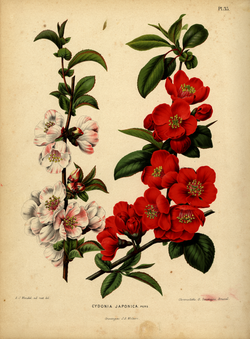Biology:Chaenomeles speciosa
| Chaenomeles speciosa | |
|---|---|

| |
| Illustration by A.J. Wendel, 1868 | |
| Scientific classification | |
| Kingdom: | Plantae |
| Clade: | Tracheophytes |
| Clade: | Angiosperms |
| Clade: | Eudicots |
| Clade: | Rosids |
| Order: | Rosales |
| Family: | Rosaceae |
| Genus: | Chaenomeles |
| Species: | C. speciosa
|
| Binomial name | |
| Chaenomeles speciosa (Sweet) Nak.
| |
| Synonyms[1] | |
| |
Chaenomeles speciosa, the flowering quince, Chinese quince, or Japanese quince[2] (in the context of traditional Chinese medicine known as zhou pi mugua (皱皮木瓜)),[3][4] is a thorny deciduous or semi-evergreen shrub native to eastern Asia. It is taller than another commonly cultivated species, C. japonica, usually growing to about 2 m (6 ft 7 in).[2] The flowers are usually red, but may be white or pink. The fruit is a fragrant but hard pome that resembles a quince.[2]
Cultivation
This plant is widely cultivated in temperate regions for its twining habit and its showy flowers which appear early in the season, occasionally even in midwinter. It is frequently used as an informal low hedge. Numerous cultivars with flowers in shades of white, pink and red have been selected. The following cultivars and hybrids have gained the Royal Horticultural Society's Award of Garden Merit:[5]
The following cultivars have received the Royal Horticultural Society's Award of Garden Merit:
See also
- Pseudocydonia (C. sinensis), also called mugua and Chinese quince; also extensively used in traditional Chinese medicine
- Papaya, a tropical fruit that shares the name mugua
- Scutellaria baicalensis, Huáng qín (Chinese: 黄芩) another traditional Chinese herb
References
- ↑ "Chaenomeles speciosa". The Plant List. Royal Botanic Gardens (Kew). http://www.theplantlist.org/tpl1.1/search?q=Chaenomeles+speciosa.
- ↑ 2.0 2.1 2.2 Bailey, L.H.; Bailey, E.Z.; the staff of the Liberty Hyde Bailey Hortorium. 1976. Hortus third: A concise dictionary of plants cultivated in the United States and Canada. Macmillan, New York.
- ↑ {{citation | mode = cs1 | title = Chaenomeles speciosa | work = Germplasm Resources Information Network (GRIN) | url = | publisher = [[Organization:Agricultural Research ServAgricultural Research Service (ARS), United States Department of Agriculture (USDA) | access-date = 2 March 2014 }}
- ↑ Subhuti Dharmananda 2005. "Chaenomeles: A relaxing and strengthening fruit" in Institute for Traditional Medicine database [1]
- ↑ "AGM Plants - Ornamental". Royal Horticultural Society. July 2017. p. 16. https://www.rhs.org.uk/plants/pdfs/agm-lists/agm-ornamentals.pdf.
- ↑ "Chaenomeles speciosa 'Geisha Girl'". RHS. https://www.rhs.org.uk/Plants/29024/Chaenomeles-speciosa-Geisha-Girl-(d)/Details.
- ↑ "Chaenomeles speciosa 'Moerloosei'". RHS. https://www.rhs.org.uk/Plants/54394/Chaenomeles-speciosa-Moerloosei/Details.
- ↑ "Chaenomeles × superba 'Pink Lady'". RHS. https://www.rhs.org.uk/Plants/97837/Chaenomeles-x-superba-Pink-Lady/Details.
External links
| Wikimedia Commons has media related to Chaenomeles speciosa. |
Wikidata ☰ Q159324 entry
 |

